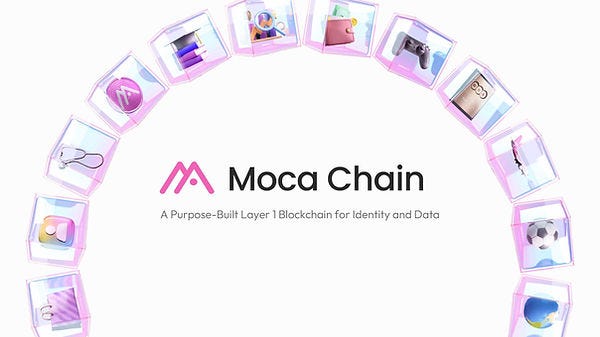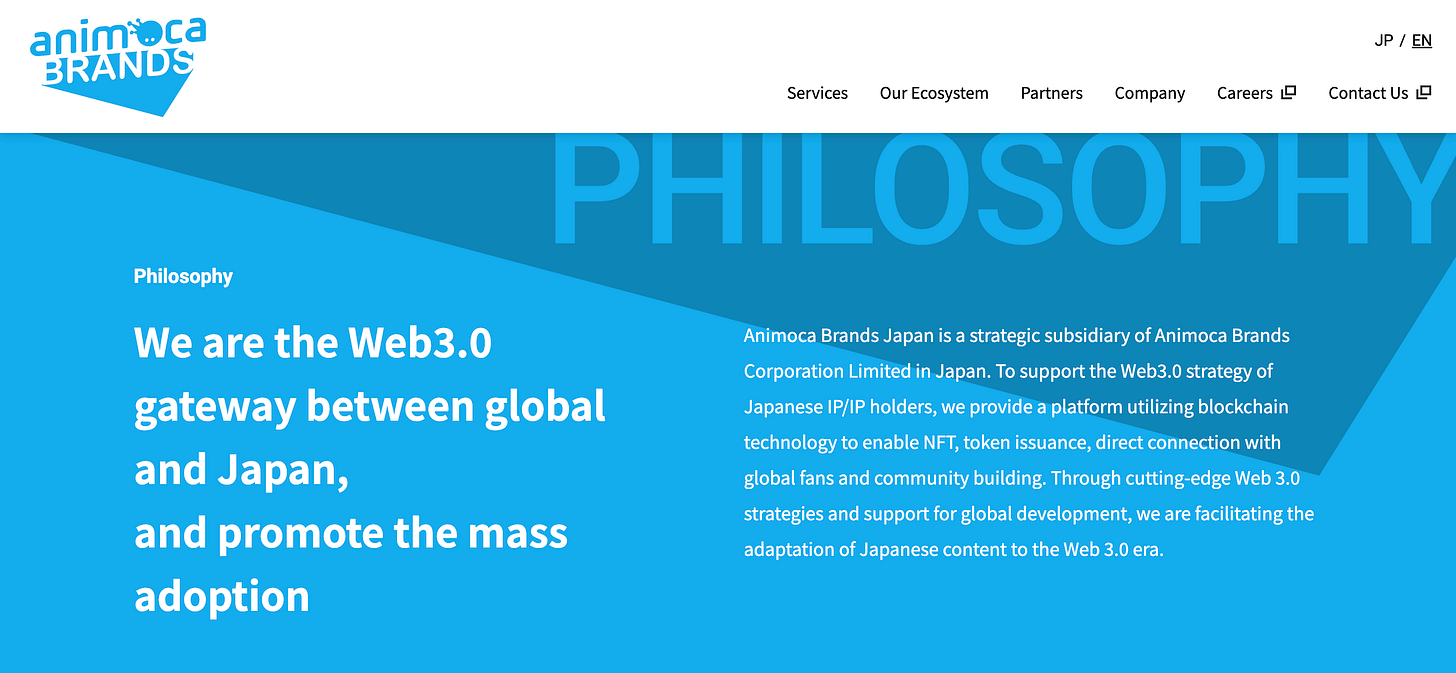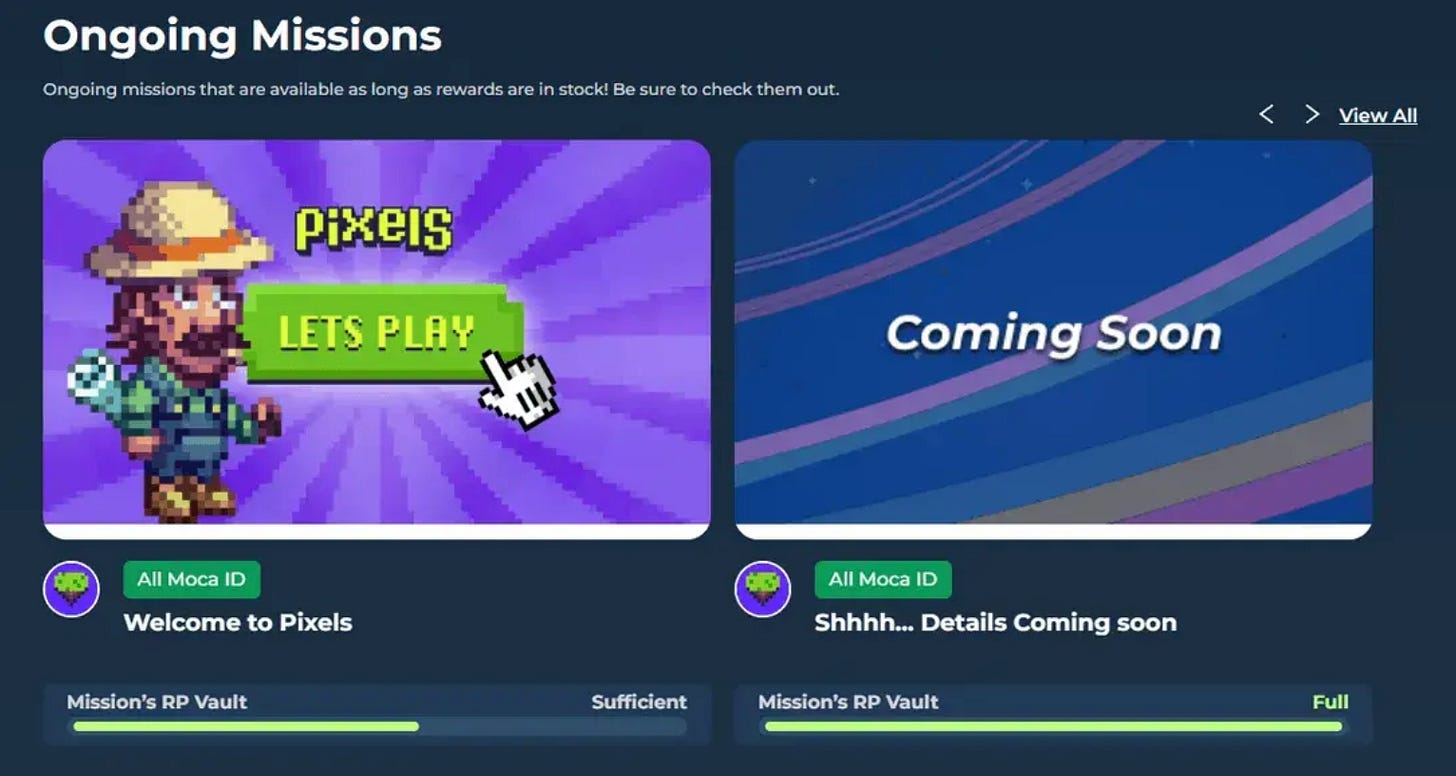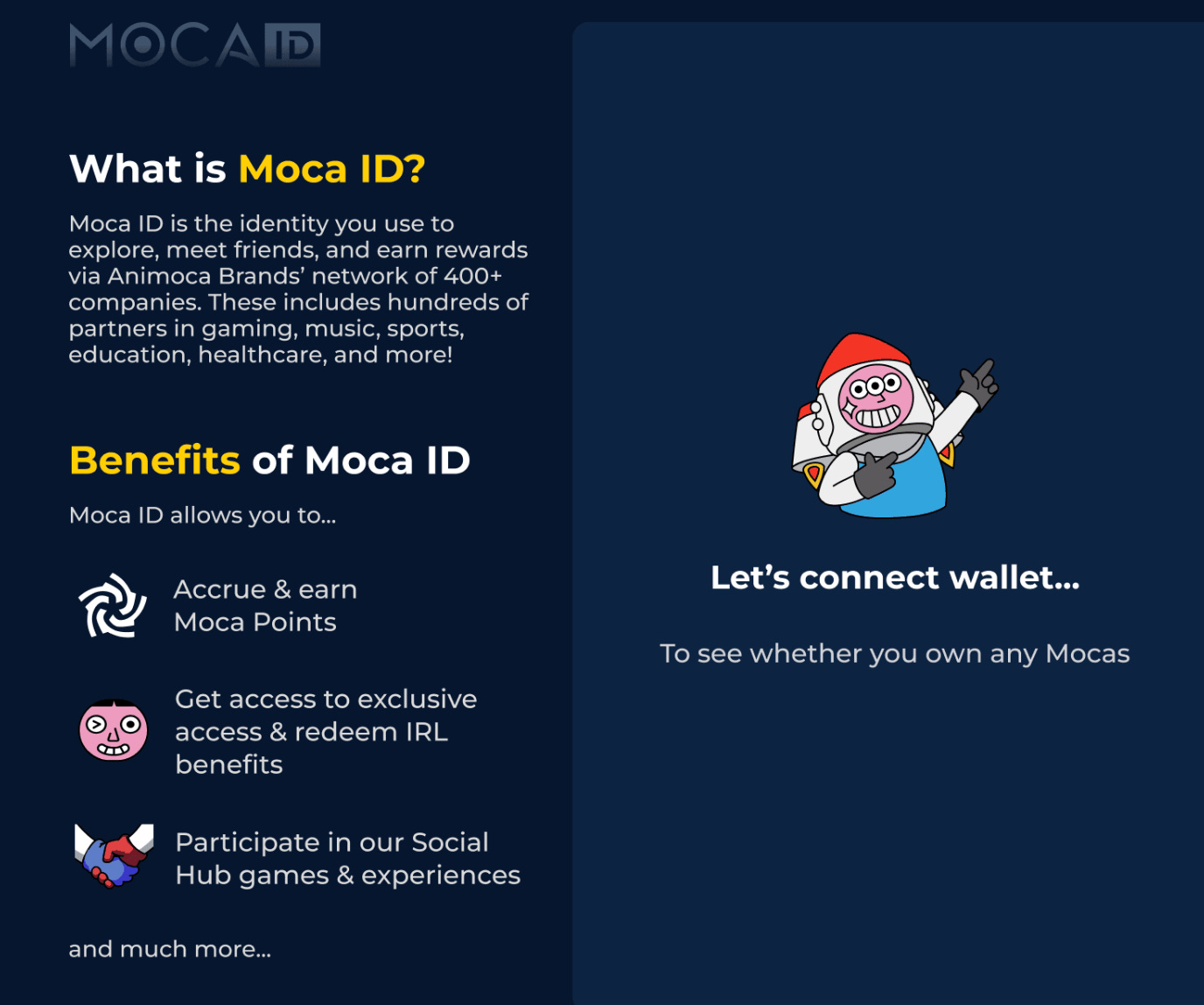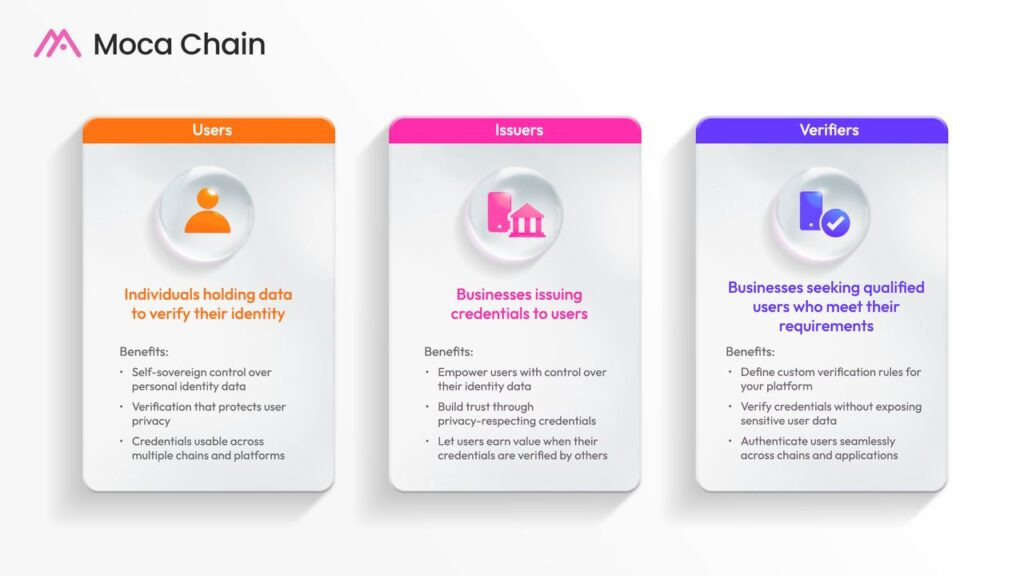【Moca Chain】L1 blockchain to be the infrastructure for the "world's largest ID network" led by Animoca Brands / @Moca_Network
It may be the next generation DID infrastructure.
Good morning.
I am mitsui, a web3 researcher.
Today we researched the Moca Chain.
⛓️What is Moca Chain?
⚙️How the Moca Chain works
👀 use case
💬 Will it be the next generation DID infrastructure?
🧵TL;DR
Moca Chainis an Animoca Brands-led layer 1 blockchain that specializes in self-sovereign digital identity and privacy protection and aims to become "the world's largest identity network.
Animoca Brandsis a major web3 investor in more than 500 companies, including The Sandbox and REVV Racing.
Mocaverse (NFT membership card) will be launched in 2023, expanding the distributed ID base through Moca ID and Realm Points.
This was followed by the development of the AIR Kit/AIR ID → Moca Network → Moca Chain, and the governance and utility design using $MOCA tokens was put in place.
⛓️What is Moca Chain?
The Moca Chain is a self-sovereign, privacy-preserving, layer 1 blockchain for digital identity and user authentication, and is part of the Moca Network, an identity infrastructure led by Animoca Brands, which aims to become "the world's largest It aims to be "the starting point for the world's largest identity network".
As mentioned above, the "Moca Chain" is a blockchain that is being built as part of the "Moca Network" project, so we will start with the big picture.
◼️Animoca Brands
As you may know, we will start with Animoca Brands, which is leading the operation.
Animoca Brands is one of the world's leading web3 companies based in Hong Kong and one of the leading blockchain game, NFT and Metaverse related businesses.Founded in 2014 by Yat Siu and others, the company was initially a mobile game publisher but around 2018, the company made a major shift to NFT and blockchain technology.
Representative projects include the metaverse "The Sandbox," the motorsports NFT game "REVV Racing," and the education platform "TinyTap," promoting web3 applications in a wide range of areas from games to education, sports, and music. In addition, the company is also an investment firm and has invested in over 500 web3 startups, including OpenSea, Axie Infinity developer Sky Mavis, Dapper Labs, and Yuga Labs.
◼️Mocaverse
The flagship NFT project launched by Animoca Brands in early 2023 was "Mocaverse," which evolved and later became the "Moca Network.
Mocaverse was originally created as a membership NFT collection for the Animoca Brands ecosystem, consisting of 8,888 unique "Moca" characters and designed as a PFP.
Moca NFT holders were granted a wide variety of benefits, including priority participation in Animoca Brands-related projects, exclusive drops, and community access. For example, they could participate in alpha testing of new games, be automatically added to the partner's token sale preference list (Arrow List), and receive invitations to exclusive events.
Initially, Mocaverse was positioned as a membership card that could be used across the hundreds of projects funded and affiliated with Animoca Brands.
Mocaverse also included the concept of "Realm," with activity categories such as Learn, Play, Do Good, and Build. This was designed as a points program, so to speak, in which "Realm Points (RP)" were accumulated through participation in activities in each category.
However, the supply of 8,888 units was not enough to meet the rapidly growing community demand. This is where "Moca ID" came in.
◼️Moca ID
Moca ID is an on-chain DID to allow community participation beyond Moca NFT holders and was provided in the form of SBT instead of NFT. The system was put in place in mid-2023.
This allows selected web3 community members to participate in the Mocaverse DID system, even if they are not directly affiliated with Animoca Brands. Moca ID holders are also entitled to earn Realm Points and have visibility into their community contributions without distinction from Moca NFT holders.
With the Moca ID system, Mocaverse participants quickly expanded from a few thousand to tens of thousands.
◼️AIR ID/AIR Kit coming
In late 2023, Animoca Brands began to extend the vision of Mocaverse with a mission to "provide a user-centric identity and reputation infrastructure, web3 and web2 alike. The vision is to build a large-scale infrastructure of decentralized digital identity that extends beyond a closed community of NFT holders to the entire general Internet user base.
The specific products that followed were the AIR Kit and AIR ID.
AIR Kit, which stands for "Accounts, Identity, Reputation," was offered as a developer toolkit integrating account management, ID issuance, and reputation scoring modules.
This allows web3 developers as well as web2 companies to add distributed ID functionality to their apps and services with a few lines of code and implement new features that leverage users' on-chain experience.
And at the core of this AIR Kit is the AIR ID: whereas the Moca ID was a Mocaverse-specific DID, the AIR ID is a global account identity and reputation layer in a broader sense. Every action a user takes (e.g., participating in DAOs, investing in DeFi, completing quests in games, inviting friends, etc.) is issued as a Verifiable Credential, which can then be accumulated to form a user-specific reputation and credit score.
In essence, this is a generalization of the single sign-on technology (Moca ID) and point system (Realm Points) developed in the Mocaverse, and we have begun to develop them as SDKs that can be integrated into any application.
◼️Development to Moca Network
As the technology from Mocaverse became popularized and white-labeled as described above, it expanded from a membership card project within Animoca Brands called "Mocaverse" to a large network called "Moca Network".
In a nutshell, Moca Network is a project that aims to become the "world's largest chain-independent distributed identity network. We aim to build a unified DID regardless of chain, regardless of web3 or web2.
Moca Network grew rapidly from 2023 to 2024. This is due to the presence of strong partners. For example, communities with huge user bases such as OneFootball (soccer), MyAnimeList (anime), and TON (messaging) joined.
◼️Moca Foundationと$MOCA
As an extension of this movement, the Moca Foundation was established in 2024 to lead the Moca Network. At this time, the Moca Foundation is led by members of Animoca Brands, but eventually it will implement decentralized governance based on its own token $MOCA and be run by the Moac DAO.
And $MOCA is a utility and governance token used throughout the Mocaverse, Moca Network and MocaChain. 8,888,888,888 tokens are issued, mainly Ethereum and Base, but with the use of Layer0, it is multi The main focus is on Ethereum and Base, but it can be deployed on multiple chains by using Layer0.
The $MOCA utilities are as follows
Gas & Commission Payment:.Fees (gas fees) for transaction execution and data issuance and validation on MocaChain are paid in MOCA. For example, the issuance and validation of credentials incurs a fee in MOCA, which is the validator fee or payment to the data issuer
Staking and Network Security:.The validator stakes MOCA to generate and verify the network blocks.
Data Storage: 1.A certain amount of MOCA must be held (locked) per user for distributed data storage use.
Oracle Usage Fees:.When another chain invokes MocaChain's authentication service via a cross-chain oracle, its Verifier pays a fee at MOCA.
Data generation (e.g. zkTLS):.MOCA is also used for web data attestation processes using zkTLS and other off-chain data capture.
Incentives and Rewards:.MOCA will be distributed as a reward to Moca Network participants.
Governance Vote: 1.The amount of MOCA held will be reflected as a weight when voting on Moca DAO. MOCA is required to vote on key proposals and delegate votes to delegates.
◼️Moca Chain
In this vein, the Moca Chain concept was announced in June 2025.
Moca Chain is an EVM-compatible Layer 1 chain for self-sovereign digital IDs and is positioned as the infrastructure to expand the Moca Network.
As explained above, the Moca Foundation is the main entity that develops and operates this Moca Chain and is the Moca DAO. The native token is $MOCA.
The test net is currently open to the public and the main net is scheduled to open in Q4 2025.
⚙️How Moca Chain works
Now that the flow has been explained, let's look at how the "Moca Chain" works in a little more detail.
◼️ account-abstract
MocaChain is an EVM-compatible blockchain that is highly compatible with Ethereum.
So, it is basically the same as a general EVM compatible chain, but as a unique extension, an account abstraction feature called "smart account" is introduced. This enables advanced wallet features such as multisig and social recovery, as well as payment on behalf of transaction fees (PayMaster feature), etc.
Developers can easily implement these smart accounts using the AIR Kit, an SDK provided by Moca Network, and seamlessly integrate user registration and authentication flows into the DApp.
◼️ Data Structures and Distributed Storage
MocaChain incorporates distributed data storage to store and share user authentication data and credentials.
Traditionally, user data has been distributed and siloed across services, making it difficult to reuse and dependent on a centralized administrator; MocaChain stores user credentials on the blockchain and in peer-to-peer distributed storage, which users control with their own cryptographic keys. MocaChain keeps user credentials on the blockchain and in peer-to-peer distributed storage, controlled by the user's own cryptographic key.
This storage is redundant and fault-tolerant with no single point of failure, and data can be shared and reused among multiple services to the extent permitted by the user. For example, a user's academic credentials or health records can be issued and stored once, and then verified by other institutions with the user's permission.
The use of distributed storage adopts a model in which each user's data storage quota is secured by holding a certain amount of $MOCA tokens within the network.
◼️Privacy Protection and Zero Knowledge Proof Technology
A key feature of MocaChain is its privacy protection mechanism utilizing Zero Knowledge Proof (ZKP). User data is stored in encrypted form, and only the proof is disclosed to third parties; the original data itself is never shared.
As a specific elemental technology, MocaChain natively supports on-chain ZK proof verification. Cryptographic proofs generated by users and data issuers can be verified by smart contracts on the blockchain, resulting in tamper-free authentication results.
It also implements the "zkTLS" function, which enables Web2 data (e.g., social media achievements and bank account transaction history) that was previously obtained via APIs to be obtained and certified while protecting privacy.
Note that there is a $MOCA token fee for the generation of proofs on MocaChain. For example, the generation of zero-knowledge proofs (data issuance) is paid for by MOCA and data validity is supervised by Network Governance.
◼️ cross-chain support and identity oracles
MocaChain emphasizes cross-chain compatibility, allowing for ID and data verification in different blockchain environments.
At its core, theIdentity OracleThe mechanism is called
Identity Oracle is a bridge function that allows smart contracts on other blockchains to query and use authentication information held on MocaChain.
Specifically, if a DApp on another chain wants to perform some kind of verification on a user (e.g., "Has this user been KYC'd?" ), the DApp on other chains can query the MocaChain oracle contract to obtain the existence and content of the verified credential held by the user. The credential itself is provided in a zero-knowledge format, and privacy is maintained.
◼️ summary
In general, I think we have understood that Moca Chain is an ecosystem for DID. Any chain, even Web2, can store and accumulate any information, which can then be verified by a third party on a zero-knowledge proof basis.
Below is a diagram showing the major participants in the Moca Chain.
The MocaChain ecosystem consists of three major stakeholders: Users, Issuers, and Verifiers, each with different roles and benefits.
First, Users are individuals who retain their own identity data and present it as needed. Users can manage their personal data in a self-sovereign manner, allowing them to authenticate while protecting their privacy. Furthermore, once issued, credentials can be used across multiple chains and platforms.
Issuers, then, are companies or institutions that issue credentials (credentials) to users. Examples include college diplomas, bank KYC certificates, and in-game achievements. Issuers can build trust through privacy-sensitive authentication, providing proof while giving users data ownership. Another feature is that the issued credential can be verified by others, returning new value to the users themselves.
Finally, Verifiers are responsible for verifying the credentials issued and authenticating users who meet their company's requirements. Typical examples are employers, financial services, and gaming platforms. Verifiers can perform custom authentication based on their own defined rules, and by utilizing zero-knowledge proofs, they can authenticate without touching sensitive personal information. Furthermore, this mechanism allows users to authenticate seamlessly across multiple chains and apps.
👀 use case
The following is a brief overview of the use cases that have been linked to date.
1. finance/KYC area
Partnership with zkMe
Zero-knowledge proof of age verification, nationality verification, credit score, and investor eligibility is issued.
Exchange and financial services allow "multiple uses in a single KYC".
No sensitive personal information is disclosed, ensuring both regulatory compliance and privacy protection.
2. loyalty program
SK Planet(OK Cashbag)
Cooperation with one of the largest point services in Korea (28 million users).
Purchase history and point activities are linked to AIR IDs for on-chain results.
Users receive benefits and rewards based on their performance, and the data can be used for other services.
3. sports
OneFootball(Football ID)
Introduced to an app for soccer fans with over 200 million monthly users.
Issue a unique ID in the form "name.football".
Spectator history and fan activity are recorded on-chain and used for privileges and exclusive access.
4. animation and culture field
MyAnimeList (Anime ID)
Visualization of the behavioral history of anime and manga fans as DIDs.
Review submissions and event participation history are used as provable data.
Applied to granting benefits within the fan community, such as purchasing limited-edition merchandise and supporting new releases.
5. game field
Pixels, BLOCKLORDS, Ubisoftなど
Credentialing in-game achievements and play time.
Can be used for conditions and benefits of participation in other games and communities.
Function as a bridge between web3 games and conventional games.
6. education and qualifications
Linkage with Open Campus
Degree certificates and training certificates are issued as Verifiable Credential.
Job search and educational credentials can be shared in a non-falsifiable manner.
7. medical/healthcare sector (conceptual stage)
Electronic medical records and test results are managed by the individual's own sovereignty.
If necessary, the information is shared with medical providers, and only necessary information, such as allergies and medical history, is presented with zero-knowledge certification.
8. marketing and advertising
Users can set their own data usage range in detail.
Advertisers use only permitted attribute data, and users are rewarded back.
Provides a "user-driven data utilization model" that replaces cookie-dependent advertising.
In this way, MocaChain is evolving as an ID infrastructure that can be used across the spectrum from "financial identity verification" to "cultural communities," and is expanding into various industries with a mechanism for users to gain value in the economic sphere while owning their own data.
💬Will it be the next generation DID infrastructure
The final section is a summary and discussion.
First, the DID market is a rather difficult area to consider its potential. The reason is that network effects are of paramount importance.
DID and VC will become more convenient once they are widely used, but before they are widely used, they are inconvenient, so there is little merit in using DID in the early stages. There is no incentive on the certification issuing side, and if proofs are not accumulated, DIDs cannot be used to prove individuals, and if so, there is no merit on the certification side.
Without solving this chicken-and-egg theory, DIDs will not spread, and that is why we use token incentives, but even so, ID infrastructures around the world are orders of magnitude different. Even a few million or tens of millions of users is a huge project in the crypto world, but to become an ID infrastructure, you need to build hundreds of millions to billions of users.
Against this background, DID has been considered an area that has attracted attention but has been difficult to spread.
I am quite excited that Animoca Brands has its eyes on this and is promoting it. Because they have already built a huge ecosystem, just introducing IDs into it will give them a certain scale, and because they have the financial resources, it will be very easy to design incentives for expansion.
And it is noteworthy that we are actively working with the Web2 platform. Paymaster functionality with account abstraction is implemented even when a chain is issued, and zkTLS can also be used for authentication.
Personally, I believe that in the DID area, where the power of scale is important and the ability to secure partnerships is important, the Moca Network and Moca Chain, initiated by Animoca Brands, will be a very powerful leading project.
We are very much looking forward to the future development of Moca Chain, as the main net should be launched and fully deployed in the near future.
This is the research for the Moca Chain!
🔗Reference Link:Moca Chain / Moca Foundation / Mocaverse / Moca Network / Animoca Brands
Disclaimer:I carefully examine and write the information that I research, but since it is personally operated and there are many parts with English sources, there may be some paraphrasing or incorrect information. Please understand. Also, there may be introductions of Dapps, NFTs, and tokens in the articles, but there is absolutely no solicitation purpose. Please purchase and use them at your own risk.
About us
🇯🇵🇺🇸🇰🇷🇨🇳🇪🇸 The English version of the web3 newsletter, which is available in 5 languages. Based on the concept of ``Learn more about web3 in 5 minutes a day,'' we deliver research articles five times a week, including explanations of popular web3 trends, project explanations, and introductions to the latest news.
Author
mitsui
A web3 researcher. Operating the newsletter "web3 Research" delivered in five languages around the world.
Contact
The author is a web3 researcher based in Japan. If you have a project that is interested in expanding to Japan, please contact the following:
Telegram:@mitsui0x
*Please note that this newsletter translates articles that are originally in Japanese. There may be translation mistakes such as mistranslations or paraphrasing, so please understand in advance.



